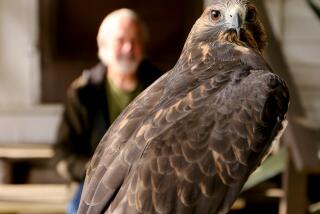Midway Atoll Is Off-Limits Again
- Share via
Midway Atoll National Wildlife Refuge, site of the infamous World War II battle but more recently a gem of a destination for fishermen, divers and eco-tourists, is no longer accessible to the public.
Midway Phoenix Corp., which has managed the airport and tourism services since the remote atoll went public in 1996, said this week that it has decided to end what it calls an “unacceptable” relationship with the U.S. Fish and Wildlife Service and cancel its contract with Aloha Airlines. There are no more inbound passenger flights. The last outbound flight, carrying the remainder of Midway Phoenix employees, is scheduled March 2.
For the record:
12:00 a.m. Feb. 2, 2002 FOR THE RECORD
Los Angeles Times Saturday February 2, 2002 Home Edition Main News Part A Page 2 A2 Desk 1 inches; 23 words Type of Material: Correction
Midway Island--Midway Phoenix Corp. is not a subsidiary of Midway Air Group, as reported Friday in the Outdoors column in Sports. They are two separate companies.
However, Fish and Wildlife spokeswoman Barbara Maxfield said the agency has “yet to receive anything in writing that formally terminates our cooperative agreement.”
The unique public-private agreement had been seen as the only viable means of maintaining the infrastructure while at the same time enabling an official government presence on the atoll, a two-island speck in the Hawaiian Island chain located 1,300 miles northwest of Honolulu.
The concept was simple. Tourism would fund management of the airport, employee and guest housing, the running of power plants and purchasing of fuel. Refuge personnel would be in charge of flora and fauna.
But the partnership was precarious from the beginning.
“I wouldn’t say we were the Hatfields and McCoys, but we were operating under two different philosophies and living in two different worlds,” said Bob Tracey, executive vice president of Midway Phoenix, a subsidiary of Phoenix Air Group in Cartersville, Ga. “They were not visitor-friendly and were increasingly telling our guests what they couldn’t do rather than what they could do. We’ve had it with their dictatorial attitude.”
Guests are told upon arrival to distance themselves from wildlife whenever possible. About 2 million seabirds--15 species in all--nest on the shores of Sand and Eastern islands, which are home to the world’s largest breeding population of Laysan albatross. The Hawaiian monk seal is among the endangered animals afforded an especially wide berth from humans.
Tracey said the government agency’s insistence on killing ironwood trees, which are not indigenous but provide the only relief from the sun, is further evidence that biologists favor returning Midway to its natural state over the accommodation of tourists.
Refuge manager Rob Shallenberger, who said restrictions on tourists are no greater than they have been from the beginning, has denied killing trees on Sand Island, the only populated island. Midway Phoenix employees have charged otherwise.
Tourism also has been affected deeply by the state of the economy and by concerns over the safety of travel. But restrictions on tourists, he added, were making it increasingly difficult for Midway Phoenix to meet its $399,420 monthly operational costs.
Maxwell countered by saying that the original agreement called for no government expenditure at Midway, but that Fish and Wildlife expenditures to date have totaled about $5 million.
If this is the end of the partnership, and if another private company does not step in and take Midway Phoenix’s place, it will have a ripple effect. The U.S. Coast Guard would lose a mid-ocean refueling stop and overseas commercial air carriers would lose an emergency Pacific Ocean landing base, which is required for certain aircraft.
Tourists, and students involved in research programs at Midway, would lose access to a place aflutter with avian wonders--including the rare golden gooney--and to a lagoon that is frequented by everything from colorful little reef fish to enormous tiger sharks.
Maxwell said that regardless of what happens, the Fish and Wildlife Service intends to maintain a presence on the atoll. “Of course it’d be a small group,” she said. “And we’d have to find other ways to get back and forth.”
It’s not clear what would become of the structures and other mementos left by the U.S. Navy before its pullout was completed in 1997. Or of the memorial on Sand Island honoring those who lost their lives during the Battle of Midway.
*
Southern California skiers and snowboarders will find the best conditions of the season on the local slopes. This week’s storm, by far the coldest and most significant of the season, dumped up to 11/2 feet of light powder in the San Gabriel and San Bernardino mountains, boosting base depths to nearly three feet.
More to Read
Sign up for The Wild
We’ll help you find the best places to hike, bike and run, as well as the perfect silent spots for meditation and yoga.
You may occasionally receive promotional content from the Los Angeles Times.






